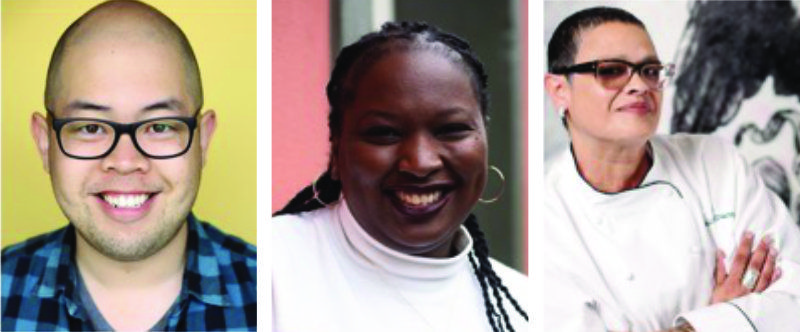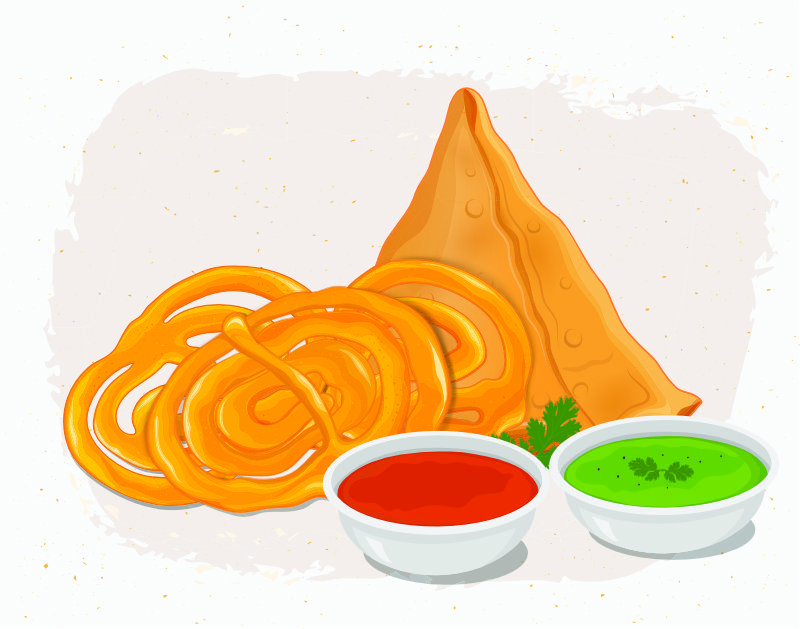How Ethnic Food Triumphs in a Polarized America
Few things are more universally accepted as food, no matter where it comes from. Every ethnic group in the United States and every immigrant community or region that settles in this country brings a taste of home and, at the same time, is influenced by the ingredients and traditions already here.

At a briefing by Ethnic Media Services, July 1, speakers – Quincy Surasmith, Managing Editor, “Feet in 2 Worlds” and producer of “A Better Life?” podcast, season 2. He is also the host and producer of “Asian Americana”; Kayla Stewert, award-winning food and travel writer, columnist at “The Bittman Project,” featured in “The New York Times,” “Southern Foodways Alliance,” “The Wall Street Journal,” “The Washington Post,” “Condé Nast Traveler,” “Bon Appétit,” “Travel + Leisure,” and others; and Chef Silvana Salcido Esparza, raised in the back of a Mexican bakery in Central California. Her company “Barrio Empire” has restaurants in Phoenix, Arizona and she is active in her local community – examine the growing influence of food created by ethnic and immigrant communities and what the meaning of “authentic” food is.
The briefing was co organized by Feet in 2 Worlds, producers of the award-winning podcasts “A Better Life?” and “Food in Two Worlds.”
“What’s more American than Apple Pie, maybe an assortment of Thai desserts, Indian sweets?
Created by food entrepreneurs across all racial and ethnic communities, this is a fun topic that shows positive trends in America,” said Sandy Close.
Quincy Surasmith, Managing Editor, “Feet in 2 Worlds”
“I do a lot of reporting and research about Asian American cuisine, culture, and history, and something that comes up a lot is this idea of a balance of what gets to be a classic American cuisine, or a classic American history or culture in general.
“A few things that have come from Asian American cuisine, have become kind of classic American food because a lot of food that come from all sorts of immigrant communities that are in the U.S., become not only part of the food environment and tapestry in the U.S., but they adapt and change.
“A middle-class white customer base is not the only customer base, and that’s not the only reason these people make this food, some classic examples are ‘chop suey’ which comes from Chinese American restaurants though it’s not a traditional Chinese dish in China but is made by Chinese Americans in the U.S.
“Fortune Cookies are classically American food because you do not find those in China. They are a Japanese cookie, traditionally, but even then, it was not an everyday cookie. It was like a special occasion cookie.
“Fried Wonton Chinese Chicken Salad, the California role again, not of Japanese origin but invented in Little Tokyo by Japanese Americans in Los Angeles in the late 60’s or early 70’s.
“Teriyaki Chicken with Rice and a Salad with Thousand Island Dressing on it, is a very classic Seattle lunch, and a lot of these come from ingredient changes and substitutions that are made by people in the community.
“Other examples that are much more modern that may become part of classic American but also classic Asian American cuisine. John Eric Concordia, who runs the park’s finest barbecue in historic Filipino town in Los Angeles, is mixing Filipino flavors with LA style – like LA/American style Smoked Barbecue.
“There’s a Bopo Mofo Cafe that makes Maple Tofu Tater Tots, or like Indian Curry Pizzas or South Asian Curry Pizzas in Artesia, Calif.
“In the Bay Area, South Asian Curries have their own complex history of how they’ve evolved over different places and by who’s cooking them. The Vietnamese Shrimp Crawfish boil that has become chains like Boiling Crab, and such, come from Vietnamese American communities that are in the Gulf Coast and have learned the food ways there and adapted with their own flavors. “Korean Barbecue, in Korean restaurants, the short rib cut is called La Calbi which is like referring to the Los Angeles style of cutting that meat.
“These are examples of things that change and shift here because of cultural influence and because of what is available. It’s all real, it’s all authentic. Authentic is different than traditional. Traditional is a certain thing and I want to respect that but in the Asian American community people ask ‘Well, is this traditional, is this authentic?’ and we try to box it out because we want to protect our own histories and culture.
“I want to encourage people to think about food as not being put into little boxes but as kind of signposts to all the intersecting roads it’s crossed and the specificity of the region, of people, whether it’s a region in the U.S., or the region where their families or they themselves are from, in these other places, what it’s influenced by.
“I encourage people to think about who gets to make food; who is it made for; and who is it made by; who gets to benefit from making that kind of food; who gets to succeed and get awards?” said Surasmith.
Kayla Stewert, award-winning food and travel writer
“Many people assume that African American food is Macaroni and Cheese, Collard Greens and Fried Chicken. Yes, they are wonderful meals, and they absolutely are part of our food, but they are by no means the only food that we eat. A lot of times those dishes are actually used as ways to insult us or impart stereotypes that have existed for centuries of our time in this country.
“There’s this separation that Black Americans have existed outside of the American canon when in fact Black Americans are part of why American food exists. A lot of the dishes that we love in the United States – Sweet Potato Pie, Macaroni and Cheese, Okra, Black-eyed Peas, these are dishes that have roots in Africa.
“Okra has roots in West Africa, and enslaved people either brought over or dishes that Black Americans have developed through their connections with Indigenous people and White people once they arrive in the United States.
“In Texas, you’ll see a lot of bar-be-cue, a lot of more traditional Southern food of vegetables and produce, chicken, and seafood. New Orleans, is the best food city in the United States, is home to Creole and Cajun cuisine which simply would not exist without black hands,” said Stewart.
“Iconic meals come from enslaved African Americans who were in these kitchens, some of whom were trained, who were paid to be trained by slave owners, and some of whom picked up these skills naturally.
“In some cases, white chefs are cooking black food, and the ones that are getting the awards and being told that they are the ones behind this cuisine. It’s important for us to combat that narrative and share the truth because again it gets back to making sure that we’re acknowledging the right people for what they’ve done, acknowledging them for their contributions, and creating new opportunities
“Something that’s really exciting about black food now is that black restaurateurs are able to feel creative and free to try new things, to take traditional cuisines and expand use global flavors, use different ways of cooking, and kind of create their own model for what black food can,” said Stewert.
Chef Silvana Salcido Esparza of “Barrio Empire”
“I’ve been threatened before as a chef like, ‘shut up and cook, there’s no politics in food’ and basically ‘be the little woman in the kitchen, and be quiet, just feed us good stuff,’ but the truth is that there is a lot of politics in food, said Esparza.
“I knew as a child that my foundation was of service to our community through our food and our bread. At age 15, I started cooking carnitas because they were non-available and i’m a big fan of pork, pork rinds and fried fat pork, and that’s a makeup Mexican staple from Michoacan. “Selling out every weekend, I got a little sense of capitalism, but as a preacher’s daughter I also have that humanity going to preach at the migrant camps. On a Saturday we’re preaching at the migrant camps and on a Wednesday I’m with my father selling bread out of the back of his truck and watching people bring out crates of tomatoes or crates of peaches to barter with my father for a gallon of milk or some bread.
“The immigrant hand is very important in the food that we serve but if I take my culture even further back, I go to the gifts that Mexico gave the world starts with corn.
“American corn was part of our food. The pit cooking of the Mayans that traveled to the north of Mexico, and it became a Chichi Mecca culture which is the pit cooking the ingredients. We’re talking about tomatoes, chilis, beans, papayas, pineapples, and goat, chocolate. All these things were gifts that Mexico gave the world, including the techniques.
“Now let’s get into discrimination, for example America’s quote-unquote ‘food is barbecue’ in fact barbecue has its own hashtag.
“I traveled the country, 17 states, studying American barbecue as a Mexican chef and what I found is that there’s a white supremacy that has taken over that food. That food developed out of the Mexican culture of the Chichi Mekkas, who with all good intention, taught North America how to pit cook, with industrialization metal, then came the portable barbecue, and then the development from Texas into the rest of America, I use that lightly, it’s the United States.
“Mexican food in the United States is not really Mexican food. It is more necessity food.
“I think about my grandfather, who came in the early 1900’s. By 1919, he was working the fields of Santa Barbara, Calif., toiling desert ground into fertile ground, which is a big mistake because of the water but nonetheless he did that. I envisioned him carrying some chilis from Durango, some peppers, his home peppers in his pocket, using some of those seeds to grow and then eating the rest because they were migrated so they were going to move from one place to another, that’s how the red sauce develops in the United States.
“If you look at food in the United States, there’s two things it is a red sauce on everything Mexican food and it is yellow cheese and those are necessity foods. You look at the barbecue sauce that’s the same thing as that red sauce. It’s a food pathways that has grown into something else, discrimination and capitalism for example, have given us those foods that I just described. It’s money at the bottom line.
“When I first opened a Barrio 20 years ago, I could see that the consumer was not experiencing my kind of restaurant from a Mexican chef. They expected chips and salsa, I gave them none. I’m a baker’s daughter, I gave them bread. They expected combination plates, the Chivas really knows, ‘where’s the tortillas, where’s the sauces?’ I gave them none of that, instead I gave them some regional food. I use it as an opportunity to change erroneous perceptions that North Americans have, not only of the food from Mexico, but of the culture that was 20 years ago, and that fight is still going.
“People are still eating their crispy tacos and going to Taco Bell, making Taco Bell America’s number one Mexican food. When you have a fresh crop of immigrants in from Oaxaca in Los Angeles giving you extraordinary food from the street food to the highest in chefs you have it in Southern California, you go to New York you have people from Puebla in New York.
“Mexican food is regional. Chicago unfortunately got the northern Mexican. Northern Mexican’s food is more Geezels and more common but those of you that have southern Mexico fresh immigration, enjoy the Mexican food that you have in your city.
“Then there’s fusion of cultures. People of color are marrying, marinating their food together, like the Korean taco, the problem is capitalism coming in and whitewashing those foods that have searched from the street because they are popular, delicious, and unfortunately that’s what happens,” concluded Esparza.


